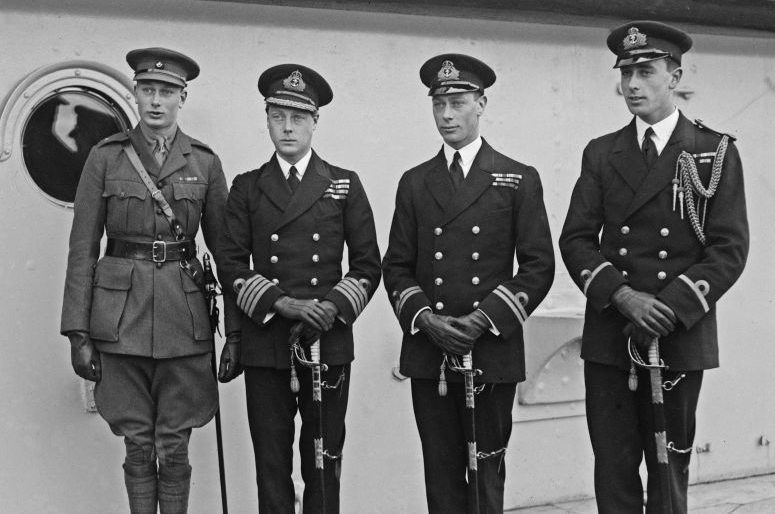Alexander Larman’s The Crown in Crisis ended with the former Edward VIII, “now exiled to Europe, traveling away in the night.” In his engrossing The Windsors at War, Larman relates what happened next. In some respects, the tale he tells can be read as a pitch-black comedy, something signaled by the dramatis personae that begins it. A “disgraced Yugoslavian prince” makes it into “Society — high” joining, among other grandees, a millionaire murder victim, and no fewer than three “playboys,” one of whom was the millionaire’s suspected murderer. A “would-be royal assassin” fares less well, banished to “Society— low,” along with the likes of a journalist (naturally) and an American engineer “unimpressed by the Duke and Duchess of Windsor.”
The Windsors at War is a lively, informative book, enriched by its author’s fondness for gossip and sharp eye for absurdity. According to Cecil Beaton, the duke had “rather common hands.” And Larman understands how to wield a footnote. In one passage, we learn that the bisexual, cross-dressing Duke of Kent, another of Edward’s younger brothers, was introduced to “myriad pleasures‡” by the American socialite Kiki Preston, the so-called “girl with the silver syringe.”
Follow the ‡ to “cocaine, morphine, group sex . . . the list is long.” If you can resist Googling “Kiki Preston,” you are made of sterner stuff than I.
Larman’s central players are, of course, the Duke and Duchess of Windsor, and above all the pompous, petulant and greedy duke, a narcissist whose self-importance had survived his self-immolation. As the book’s (punning) title suggests, at this point in Edward’s after-career his principal antagonists were his family, starting with his increasingly exasperated successor, George. George lacked his brother’s fluency and popular touch. But he lacked Edward’s flaws too and was well-equipped to provide the restorative dullness the monarchy required. And if George had been tempted to concede too much to his brother, neither his wife, tougher than her image, nor his terrifying mother would have let him.
Larman shows how, as Europe entered a second world war, the duke continued to demand, generally unsuccessfully, that his needs, most of which revolved around recognition of what he imagined to be his status, be met. No matter that those he appealed to might have more pressing priorities to deal with. Nor, in 1940, did he seem too worried about the desperate situation facing the country of which he had until recently been king. By contrast, after leaving France just ahead of the Franco-German armistice, the Windsors made what arrangements they could to either extract or protect the possessions and property they had left behind, including in the latter case contacting the Italian and German embassies.
We will never know for sure whether Edward saw the possibility that Britain might be forced to sue for peace as an opportunity to reclaim his old job, but papers discovered at the end of the war appear to back up suspicions that more was discussed with — how to put this — inappropriate people than should have been. Like some other members of his class, Edward had found much to admire in the prewar Third Reich (to be fair, quite a few Britons felt the same about Josef Stalin’s Soviet Union). Much more unusually, the outbreak of hostilities did little to change his opinions, and his preference for a quick conclusion to the war — which would have left Hitler with the upper hand — was no secret.
Berlin had long regarded the ex-king, who had been on a friendly non-state “state visit” to Germany in 1937, as a potential pawn. Under the circumstances, it’s unsurprising that the Germans hoped to inveigle the unevenly neutral Spanish to detain the Duke and Duchess in Spain as the Windsors passed through en route to relative safety in Portugal. When that came to nothing, an agent was dispatched to try, one way or another, to return them to Franco’s domain, but that too failed, closing the darkest chapter (“little less than treason,” judges Larman) in this saga.
For their part, the British wanted Edward beyond the reach of the Reich, but they didn’t want him in England. And so he was offered the governorship of the Bahamas, his own Elba, where Edward unhappily spent the rest of the war, out of sight, if not quite out of mind — there were too many “requests” from Nassau for that, as well as, almost inevitably, a scandal or two.
Meanwhile, back in Britain, George VI grew into his role as the king of a nation at war, an evolution that Larman describes well, as he does George’s growing friendship with Winston Churchill, one of Edward’s champions during the abdication crisis. History had moved on.
In October 1945, the ex-king over the water returned to Britain, “a relic,” writes Larman, “of the previous world now… treated with the mild interest that shop-soiled antiquities traditionally receive.” Thanks to official discretion about what may have taken place in 1940, it was a far milder reaction than the duke deserved. No jobs were offered, and he soon moved to France for good.





















